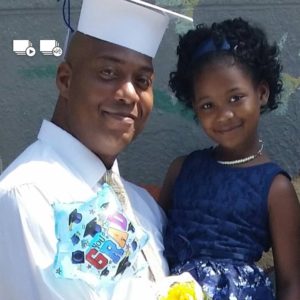After a Single Dad is Shot, a Community Reels
In Fordham Heights, neighbors deal with the aftermath of yet another death
It is hard to miss Rashuan Ahart’s apartment on Creston Avenue in Fordham Heights, the Bronx. A cardboard awning decorated with teddy bears and flowers stretches along the front of the building, housing at least a hundred glass candles. Dried-up red, white and blue candle wax obscures chalk messages on the sidewalk, where passersby stop to observe the makeshift memorial to Ahart, who was fatally shot in his home on May 9.
“It’s a cloud over the block right now,” said neighbor Marlon Davis, a Fordham Heights resident of 50 years, standing next to another cluster of flickering candles on the porch of his building. “It’s a grey cloud.”
On the day of his death, Ahart, a 35-year-old single father of a 6-year-old, heard a knock on his door. When he went to answer it, shots tore through his apartment door, striking and killing him. This is the latest incident in a neighborhood plagued by gun violence, and it has left the community tense, fearful, and tried.
“It tears up your inner soul,” said Davis. “If I was able to move out right now, I’d be gone.”

Rashaun with his daughter in 2015. (Public photo from Facebook)
Three years ago, the police organized a no-questions-asked firearm buyback program in Fordham Heights to help reduce the number of guns on the streets. Though the 46th precinct in the Bronx has seen an overall drop in shooting incidents since 2015, there were 10 shooting incidents recorded in the area during the year leading up to Ahart’s death, according to the NYPD.
In front of the memorial on Creston Avenue, hues of solemnity and sorrow cut through the sunshine. Many who stopped to pay respects refused to comment. One man asked NY City Lens to avoid taking pictures, saying it was a place of respect. About a block away, two young residents also refused to comment. “We love him and that’s why we don’t want to talk,” one said.
People remember Ahart as a man with a troubled history who had worked hard to turn his life around and be a good father.
“All he did, he did for his daughter,” said Eitan Aliaz or ‘Ace the Jeweler,’ owner of the Bronx store at which Ahart worked as a security guard.
He said everyone in the jewelry shop remembers Ahart as a generous hard worker. “He was a very peaceful person and very helpful,” he said. “He didn’t have a lot but he always giving, whether it was extra food or a couple of dollars.”
Bronx resident Beverly Morris remembers watching a young Ahart pass by her salon on East 183rd Street, stopping to say ‘Hi Ms. Bev.’ She fondly recalls that Ahart would even come into her store for haircuts as an adult.
Unlike many of his friends that age, Morris said, Ahart had worked to turn his life around after the mother of his child passed away.
“It’s really upsetting,” she said. “It’s sad, it’s sad, it’s sad.”
But in a community where violence is common there is also an unfortunate sense of banality to these deaths, Morris said. “It happens so often,” she said. “Some of us maybe have gotten immune to it.”
Davis, Ahart’s neighbor, also has painful memories of gun violence in the area. Twenty years ago, his best friend was shot and killed by another friend at a party. With so many instances of violence, from Davis’ friend 20 years ago to Ahart this week, the next question is: how will these communities heal?
“They don’t,” Davis said. “They just put it in the closet and try to live on.”

The Impact
One Shoe At A Time: A Mother Turns Pain Into Purpose
An Unsolved Shooting Baffles a Mom for Two Decades
How Grief and Anger Turned Into Action
Silver Gun: A Robbery in Queens
Shooter: “It’s Either Them or Me”
After a Single Dad is Shot, a Community Reels
